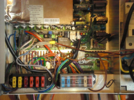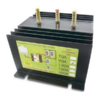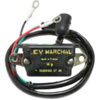Back in early 70's we had blocking diodes and split charge relays, in theroy the blocking diode was best option, but in practice the 0.6 volt drop across the diode slowed down the charging, so the relay worked better, often double contacts one for fridge direct, and other to charge leisure battery, the BS 7671:2008 stipulated how the two supplies should be used, and to comply some sort of relay in the caravan was required, with a motor caravan not limited to 13 wires, so there are other methods available. But at 13.8 volt typical for most vehicles, the charge rate was very low, using an ammeter I would see maybe 30 amp for first few minutes after starting engine, but then it would drop to around 3 amp, with narrow boats with same system cruising all day (8 hours) was not enough to recharge the batteries, and with caravans and motor homes the engine likely runs for a much shorter time.
Two major problems arrived, one was the car turning off alternator under load, and only charging on over run, and the second was if the supply to caravan was lost it could also result in the loss of the anti snake system. So a major rethink was required. With caravans the problem was is the device fitted in the caravan or the tow car, this is not a problem with motor caravans, the device is the DC to DC inverter, this does all what the relays and blocking diodes did in the past the aim is to charge the leisure battery, but ensure it is disconnected from the starting battery when engine is cranked, also to ensure the fridge is only supplied when engine is running, the latter still normally uses a relay, but the DC to DC inverter also stops back feed so no relays or blocking diodes are required, and it can also stage charge the battery.
Stage charging has been for years the norm with mobility scooters, fork lifts and milk floats, but today it has moved to another level, in some cases up to 7 stages, basic idea is charge flat out until the voltage reaches 14.4 or 14.8 depending on type of lead acid used, then hold the voltage at that setting until the amps drops to a pre-set level, then drop the voltage to around 13.4 volt this should happen when battery is around 80% charged.
However there is a problem when the battery is used at same time as being charged, as the pre-set amps at which it drops the voltage may never be reached, so there is another system where the battery is pulse charged, often used with solar panel chargers, and narrow boats, Sterling Power seem to be the leaders in this, with some really large units, mainly aimed at the narrow boat.
Basic idea is it charges, then stops, and reads the decay in voltage to work out how much charge is required, they can also combine the output of two alternators, it is common for narrow boats to have one alternator for traction battery and one for the leisure battery.
Since there are fume dangers in using gas powered fridges these with narrow boats have been replaced with compressor type units, with are all electric, the absorption fridge is normal for a caravan which can be 12 volt, 230 volt and gas, the Peltier is the other method, uses DC only, not very efficient but popular with cool boxes as it can heat or cool by swapping polarity.
The voltage activated relay was very popular at one point, and can be used to power the fridge, so it only runs when the battery is charging, but as you can see over the years there have been many methods used, job one is find out what you have, also some systems can work against each other, the vehicle alternator could stop solar panel working and visa versa.
Durite and Ring also may systems, the mppt and pwm solar panel controllers often have an output for equipment so the controller knows how much is being used, they also often have duel inputs for solar and wind generators.
Although still lead acid, the absorbed glass mat or valve regulated lead acid needs more careful controlling and often the engine management computer controls the charging, we have moved on since the 70's, and even in the 80's some batteries did seem to fail fast, I know the Chevy sealed batteries would not give much warning they were going flat, sorry should say discharged, shape does not alter.
Although I have seen narrow boats with fridges worked on battery, they tend to have at least 330 Ah of battery, often more, they also carry ballast so weight of battery is not a problem, they just remove some ballast, but with motor caravans the weight of the battery is a problem, so normal is to use mains or gas when parked, and 12 volt only when moving from site to site.
But if you detail what your system is, then easier to advice.





